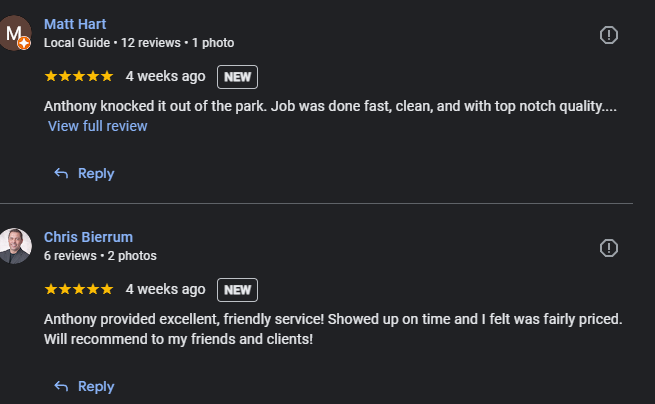With the internet being so over abundant in information, it can be hard to stand out in the never ending torrent. SEO is defined as Search Engine Optimization, which is the process of improving the visibility and ranking of a website in search engine results pages (or SERPs for short) through various techniques & strategies.
Local SEO focuses on working on making sure your services are exposed for those in your communities or areas of operation that are searching for your services.
Let’s get into some strategies that will help you not only land on the SERPs but stand out when people are searching for the very things you provide.
Hyper Local Relevance
Businesses can no longer rely on just mentioning a city or region. Local SEO now requires a more precise focus, specific neighborhoods, streets, or even blocks. Search engines favor businesses that engage with their immediate communities.
This means producing content tied to local events, landmarks, and history. This is your area of operation, and you probably know it better than anyone else. Search engines love juicy details that align with niche aspects of local life. Got a statue in your town? Mention it. Have a yearly seasonal event? Work that in.
Partnerships with other local businesses, sponsorships of community events, and neighborhood-specific keywords help create stronger connections. The goal is to demonstrate real involvement in the community rather than just claiming a presence.
Relevancy is a ranking factor when it comes to SEO.
AI-Enhanced Search Intent
Search engines have grown far more sophisticated, understanding user intent on a deeper level. AI-driven algorithms don’t just match keywords; they assess the context behind a query. This is still in its early age, and it has its flaws.
Especially when it combs other AI generated sites for information, but the practical use is there, and I don’t see it going anywhere but improving it’s already useful purposes.
To stay competitive, businesses need to craft content that answers real-world questions in a natural, conversational tone. Long-tail keywords that reflect how people actually search are more important than ever.
Structured data, relevant headers, FAQ sections, and informative, well-written content all contribute to higher visibility in search results.
Google Business Profile Optimization

Google Business Profile (GBP) is the digital storefront for local businesses. Keeping it active and optimized is essential. Accurate information, high-quality photos (with some alt text tags with it), and regular updates signal credibility and relevance.
AI-generated descriptions can be useful, but they should be customized to maintain authenticity. It’s not very difficult to add some personal flair to it.
Features like service menus, appointment booking, and customer Q&A interactions help businesses build stronger engagement. A well-maintained GBP can significantly impact local search rankings and customer trust.
Review Management

Customer reviews are more influential than ever. Search engines not only evaluate the number of reviews but also the consistency and frequency of feedback. Responding to both positive and negative reviews shows engagement and professionalism.
Businesses should actively encourage satisfied customers to leave feedback and use reviews as an opportunity to improve services. Showcasing reviews on websites and social media platforms reinforces credibility and strengthens local visibility.
- Implement a strategy to collect reviews regularly
- Respond promptly to feedback, whether positive or negative
- Feature customer testimonials on your website
- Use reviews to gain insight into customer needs and areas for improvement
Proactive review management builds trust with both potential customers and search engines, making it a key ranking factor in local SEO.
Mobile-First Approach
The dominance of mobile search continues to shape local SEO. A slow or difficult-to-navigate site can drive customers away and hurt rankings. Optimizing for mobile means improving load times, ensuring easy touch navigation, and creating a seamless user experience. Accelerated Mobile Pages (AMP) can further enhance site performance, particularly for content-heavy pages. A well-optimized mobile experience not only improves rankings but also increases conversions.
User Experience as a Ranking Factor

Google evaluates how users interact with a website. Poor engagement (such as high bounce rates or short session durations) can signal that a site isn’t valuable. Businesses should focus on clean, intuitive navigation, engaging content, and site speed improvements. Interactive features like quizzes, calculators, or dynamic content can keep visitors engaged longer. Prioritizing UX benefits both search engine rankings and customer retention.
Video Content Optimization
Video content is playing a growing role in local SEO. Businesses that produce high-quality, locally relevant videos can see a significant boost in visibility. Showcasing behind-the-scenes looks at operations, customer testimonials, or community involvement helps establish authenticity. Optimized titles, descriptions, and video schema markup improve search rankings. Incorporating video into Google Business Profile adds another layer of engagement.
- Create videos that highlight your business’s local involvement
- Optimize video titles and descriptions with local keywords
- Use video schema markup to enhance search visibility
- Embed videos on your website and Google Business Profile
- Encourage customers to submit video testimonials
By integrating video into your local SEO strategy, you can enhance engagement and build stronger connections with potential customers.
Voice Search Optimization
With smart assistants becoming a daily part of life, optimizing for voice search is ideal. People use natural language when speaking to their devices, so businesses need to match that style in their content. Common questions should be answered concisely and conversationally.
Structured data helps search engines interpret content for voice queries. Consistent business name, address, and phone number (NAP) information across the web also improves results for “near me” and “open now” searches.
High-Quality Local Citations and Backlinks
Backlinks and citations still play a vital role in local SEO. However, quality outweighs quantity. Being listed in industry-relevant, authoritative directories boosts credibility. Businesses should aim to gain organic backlinks through partnerships, local press coverage, and content that naturally attracts shares. Ensuring consistency in NAP data across platforms helps search engines verify legitimacy and improves rankings.
Social Media Integration
While social media isn’t a direct ranking factor, it strongly influences local visibility. Engaging with a local audience through social posts, check-ins, and collaborations enhances brand awareness. Featuring user-generated content and engaging with local influencers can expand reach. Businesses that maintain an active, community-focused social presence often see higher engagement and improved trust with potential customers.
Local SEO in 2025 is more dynamic, AI-driven, and user-focused than ever. Businesses that embrace hyperlocal relevance, optimize for mobile and voice search, and prioritize user experience will thrive. Staying adaptable to emerging trends and algorithm updates is the key to maintaining a strong local presence in an increasingly competitive digital landscape.





